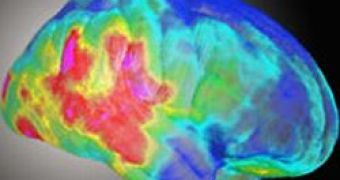A multi-institutional collaboration of scientists who investigated brain particularities of Williams Syndrome patients discovered why people who suffer from this disorder are so crazy about music and have excellent musical abilities. It is all related to structural abnormalities which appear in a certain area of these individuals' brain.
Writing in the NeuroImage Journal, researchers in the study found that people with Williams syndrome have both planum temporale sides of the same length. In a healthy, normal individual, the right planum temporale is approximately 1 inch smaller than the one situated in the left side of the brain. Therefore, this could be an explanation for the exquisite musical tastes and inclination of Williams syndrome patients towards music.
Co-author of the study, Albert Galaburda, Professor at the Harvard Medical School's Department of Neurology explained: "There are different possible explanations: Either the left side didn't grow enough or the right side grew larger than usual. The folding pattern, in particular one groove called the Sylvian fissure, pointed to an increase size of the right planum temporale.
But size alone might not explain the unusual auditory strengths of people with Williams syndrome. A more general explanation includes variations in the connectivity of certain brain regions that might contribute to the specific strengths and weaknesses in Williams syndrome."
The scientists further pointed out that studies shown how the cells in the primary visual cortex of Williams syndrome sufferers are smaller and more dense, leading to fewer and weaker connections between these cells. On the other hand, the research also found that cells in the primary auditory cortex of people with Williams syndrome are more loosely distributed and larger, which causes them to have a strong 'connectedness.'
Professor Ursula Bellugi, director of the Laboratory for Cognitive Neuroscience at the Salk Institute for Biological Studies who participated in the study stated: "These differences in cell size and density may underlie the strengths in auditory phonology, language and possibly music, and the difficulties in visual spatial construction for primary visual areas. This is really just part of the overall effect of the genes' deletion on brain development."
People with Williams syndrome are usually not very smart, with an average IQ score of 60. They are not able to deal with the visual world around them, therefore the do not have visual/spatial intelligence and perception. However, a paradox is that, despite the fact that Williams syndrome patients are not that good with images, they are great with language, music and other fields which imply creativity. For example, if an individual with the syndrome is asked to draw an object, let's say a tree, all he would do is to scribble a few lines. But if the same person is asked to describe a tree, he will make a great verbal or written description of the simple tree, close to a literature masterpiece.
"The discrepancy between their engaging social use of language and their poor visual-spatial skills is startling. I am confident that once all the evidence is in, we will have identified genes and pathways in the Williams syndrome deletion that underlie these drastic differences in modalities," concluded Prof. Bellugi.

 14 DAY TRIAL //
14 DAY TRIAL //